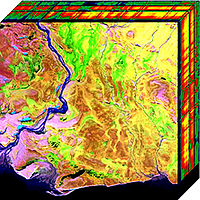
Photo from wikipedia
Abstract Information on the spatial and temporal extent of snow cover distribution is a significant input in hydrological processes and climate models. Although hyperspectral remote sensing provides significant opportunities in… Click to show full abstract
Abstract Information on the spatial and temporal extent of snow cover distribution is a significant input in hydrological processes and climate models. Although hyperspectral remote sensing provides significant opportunities in the assessment of land cover, the applications of such data are limited in the snow-covered alpine regions. A major issue with hyperspectral data is the larger dimensionality. Feature selection methods are often used to derive the most informative subset of bands from the hyperspectral data. In this study, a band selection technique is proposed which utilizes the mutual information (MI) between hyperspectral bands and a reference band. The first principal component of the hyperspectral data is selected as the reference band. Two variants of this approach are proposed involving preclustering of bands using: (1) the k-means and (2) the fuzzy k-means algorithms. The MI is derived from weighted entropy of the hyperspectral band and the reference band. The weights are computed from the cluster distance ratio and the cluster membership function for the k-means and fuzzy k-means algorithm, respectively. The selected bands were classified using random forest classifier. The proposed methods are evaluated with four datasets, two Hyperion datasets corresponding to the geographical locations of Dhundi and Solang in India, corresponding to snow covered terrain and two benchmark AVIRIS datasets of Indian Pines and Salinas. The average classification accuracy (0.995 and 0.721 for Dhundi and Solang datasets, respectively) for the proposed approach were observed to be better as compared with those from other state of the art techniques.
Journal Title: Geocarto International
Year Published: 2019
Link to full text (if available)
Share on Social Media: Sign Up to like & get
recommendations!